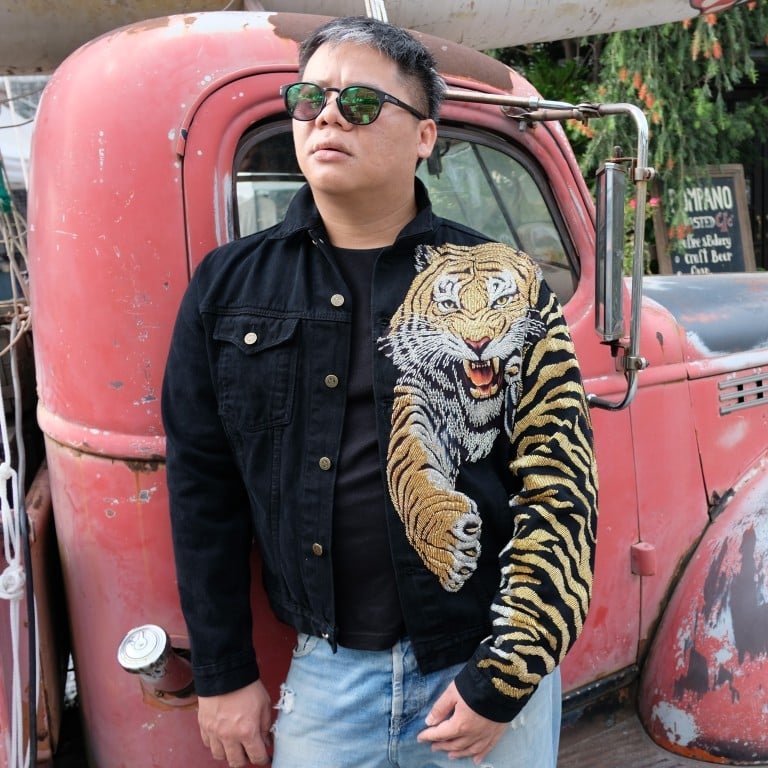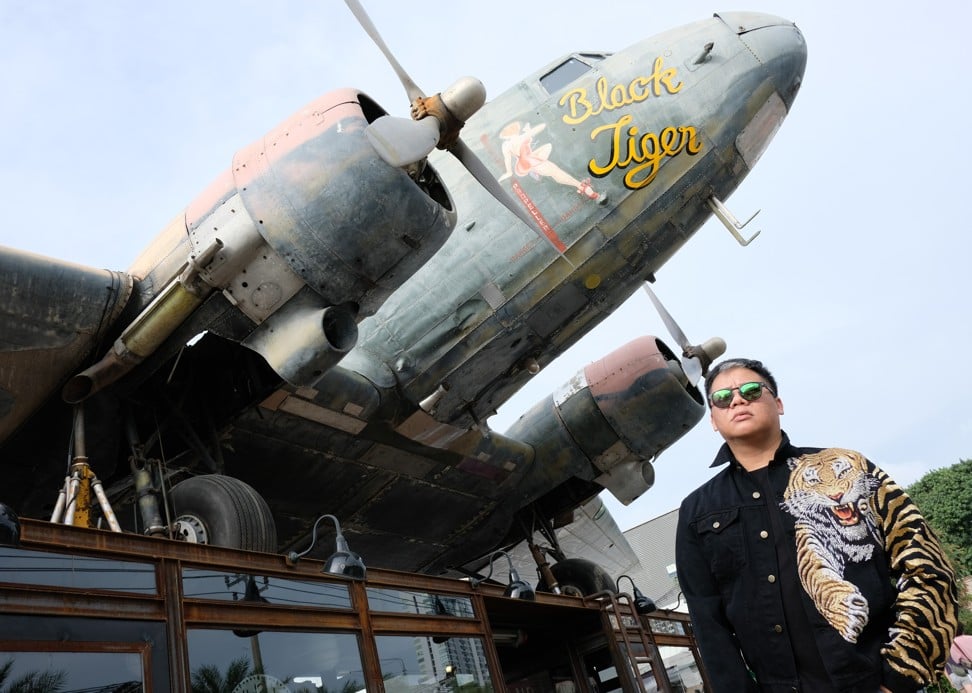
Thai fashion designer makes animal embroidery cool and fosters LGBT acceptance – ‘most of our customers are gay’
- An army of Bangkok housewives embroider the elaborate animal designs that adorn most of the items in Santichai Srisongkram’s Seasongcalm clothing line
- Santichai believes his clothes have a shamanistic power to transform their wearers
They say you are what you wear, and for Santichai Srisongkram the adage is more than a mere figure of speech.
The Thai fashion designer, founder of label Seasongcalm, believes the shimmering animal patterns that adorn most of the pieces in his clothing line can have transformative powers for the people who wear them, in a shamanistic sort of way.
“If you wear a tiger, you may feel like a tiger,” offers Santichai, 38, a cordial man who sports ribbed stonewashed jeans, a black denim jacket and mirrored shades. “I do believe that.”
His cool-as-a-rock-star outfit cloaks a man of manifestly shy disposition. Presumably, the pair of sumptuously embroidered gold-and-silver tigers – snarling and ready to pounce – that cover the back and half the front of his jacket are giving him some extra power.
Called “Thaiger-Man” (by way of a pun), the jacket, which costs 18,990 baht (US$623), is part of Santichai’s street wear line, which runs to 116 styles, including T-shirts, sweatshirts, jackets, hoodies and nightgowns.
Most are lavishly embroidered and sequinned. Many boast stylised images of growling tigers, gazing cheetahs, preening peacocks, swooping eagles or slithering serpents. Each of the animals is embroidered by hand by dexterous Bangkok housewives who work part-time for Santichai.

The Thai designer launched his clothing line two years ago and has been harnessing the power of online marketing via Instagram and other social media.
“Our designs are purposefully unisex so anyone can wear them. It doesn’t matter if they’re men, women, straight, gay or trans,” Santichai says. “But most of our customers are male, gay and under 40.”
The ostentatious embroidery is the handiwork of Amornthep Jithnak, an up-and-coming designer who started out honing his needlepoint skills by creating fancy wedding dresses. On the side, he was selling grilled pork from a street cart. “I had to make a living,” he says, almost apologetically.

His schoolteacher parents were happier with him selling pork on the street (which is widely seen as a lowly occupation in Thailand) than designing clothes, especially dresses. Amornthep, 29, is boyish looking with close-cropped hair, which at times he dyes platinum blond. He is openly gay and his effeminate mannerisms did not please his parents.
“They’re conservative and couldn’t accept the way I am. My father was especially against it. I’m his eldest child and he wanted me to be more macho,” Amornthep says.
“His beloved son playing dress-up with girls wasn’t what my father wanted. He felt I made him lose face.”
Even in freewheeling Thailand, there is a stigma attached to being gay or transgender in certain social and professional milieus. “Many gay men lead double lives – straight by day, gay by night,” says Narongchai Nateewanaphun, an accountant who works for Santichai and leads a double life of sorts himself, having stayed largely in the closet.
In Thailand’s ethnic Chinese community, many people tend to look askance at openly expressed homosexuality within close-knit family circles. “It depends on the family. With mine we do not talk about it,” Narongchai explains.
A youthful 48-year-old with a bookish mien, Narongchai has never married, which, he says, is unusual for a Sino-Thai man like himself. “I try to stay in my comfort zone. That’s why I’ve decided to work for these two gay guys,” he adds, referring to Santichai and Amornthep.
I think you dress up not just to impress other people but to impress yourself – but you do want to stand out in a crowd
Plenty of artistically inclined gay men gravitate towards Thailand’s thriving fashion industry, where they give free rein to their flamboyance and creative urges. “There’s something about embroidery that lets me explore,” Amornthep notes. “I like to create lots of fine details.”
He produces each design painstakingly, taking weeks or even months. Although he draws inspiration from paintings of animals printed on mass-produced T-shirts that are sold widely at Thai markets, he is a stickler for minutiae.
Every stripe of a growling tiger on a jacket and every feather of a preening peacock on a shirt has to be just so, otherwise creases and folds caused by wearing a garment could ruin the overall effect, he says.
“We’re trying to create designs that are unique, imaginative and eye-catching, not just something that looks mass-produced,” Amornthep says.

Usually Santichai comes up with a new idea, then Amornthep sets about executing it. “Even if a design seems very hard to do at first, we’ll still do it,” Santichai notes.
The pair’s “Thaiger-Man” creation has been selling well, particularly in China and Hong Kong. People from as far away as Colombia, Dubai and Russia have ordered customised versions of the denim jacket after seeing pictures of it online.
The jacket certainly turns heads, with its tiger stripes shimmering in the late afternoon sunlight when Santichai walks around in it at a retro outdoor market in northern Bangkok. He runs a cosy little shop there, furnished with an antique leather armchair. Decorative leather-bound books are piled beside it on the floor.
Pride of place in the market goes to a vintage, World War II-era American military plane mounted overhead beside a steampunk coffee house.
Santichai doesn’t mind the attention his tiger-patterned jacket gets him from onlookers.
“I think you dress up not just to impress other people but to impress yourself – though you do want to stand out in a crowd.”

